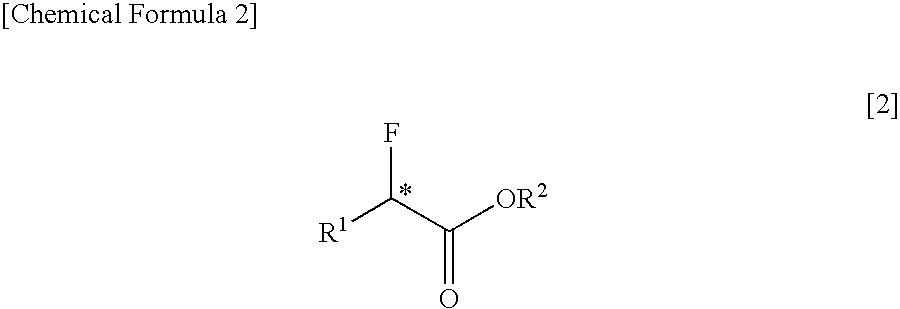PROCESS FOR PRODUCING OPTICALLY ACTIVE alpha-FLUOROCARBOXYLATE ESTER
a technology of fluorocarboxylate and ester, which is applied in the preparation of carboxylic acid esters, chemistry apparatus and processes, and organic chemistry, etc. it can solve the problems of difficult to refer to competitive industrial production processes, limited productivity of production processes, and large amount of waste, so as to achieve the effect of reducing the organic base content and fluoride ion concentration, and easy recovery of optically active -fluorocarboxyla
- Summary
- Abstract
- Description
- Claims
- Application Information
AI Technical Summary
Benefits of technology
Problems solved by technology
Method used
Image
Examples
example 1
[0060]A stainless steel (SUS), pressure-proof, reaction container was charged with 12.0 g (115 mmol, 1.00 eq, optical purity 99.0% ee or higher) of methyl (S)-lactate represented by the following formula
and 13.0 g (128 mmol, 1.11 eq) of triethylamine, followed by cooling in a refrigerant bath of −20° C. and then bubbling from a cylinder 13.5 g (132 mmol, 1.15 eq) of sulfuryl fluoride (SO2F2). The inside temperature was gradually increased to room temperature, followed by stirring at the same temperature for 2 hours and 30 minutes. Conversion of the reaction was found to be 95% or higher by determination by gas chromatography.
[0061]Then, the reaction-terminated liquid was directly subjected to a distillation under reduced pressure (degree of pressure reduction; 15 kPa, bath temperature; 70° C.), thereby obtaining 10.3 g of a distillate of methyl (R)-2-fluoropropionate represented by the following formula.
Recovery percentage was 84%. Chemical purity (calculated by gas chromatography),...
example 2
[0065]A stainless steel (SUS), pressure-proof, reaction container was charged with 258 g (2.48 mol, 1.00 eq, optical purity 99.0% ee or higher) of methyl (S)-lactate represented by the following formula
and 278 g (2.75 mol, 1.11 eq) of triethylamine, followed by bubbling from a cylinder 280 g (2.74 mol, 1.10 eq) of sulfuryl fluoride (SO2F2) while controlling the inside temperature in 0-11° C. The inside temperature was gradually increased to room temperature, followed by stirring at the same temperature for all night. Conversion of the reaction was found to be 92% by determination by gas chromatography.
[0066]Then, 76 g (0.62 mol, 2.30 eq relative to triethylamine used excessively) of benzoic acid was added to the reaction-terminated liquid, and it was subjected to a distillation under reduce pressure (degree of pressure reduction; 1.5 kPa, bath temperature; 70° C.), thereby obtaining 193 g of a distillate of methyl (R)-2-fluoropropionate represented by the following formula.
Recovery ...
example 3
[0069]A stainless steel (SUS), pressure-proof, reaction container was charged with 106.8 kg (1.026 kmol, 1.00 eq, optical purity 99.0% ee) of methyl (S)-lactate represented by the following formula
and 190.1 kg (1.026 kmol, 1.00 eq) of tri-n-butylamine, followed by cooling with a circulation-type refrigerant of −10° C. and bubbling from a cylinder 105.1 kg (1.030 kmol, 1.00 eq) of sulfuryl fluoride (SO2F2). The inside temperature was gradually increased to room temperature, and stirring was conducted at the same temperature for 4 hours. Conversion of the reaction was found to be 95% by determination by 1H-NMR.
[0070]Then, the reaction-terminated liquid was directly subjected to a distillation under reduced pressure (degree of pressure reduction; 1.0 kPa, bath temperature; 75° C.).
[0071]With this, 95.4 kg of a distillate of methyl (R)-2-fluoropropionate represented by the following formula
was obtained. Recovery percentage was 84%. Chemical purity (calculated by gas chromatography), opt...
PUM
| Property | Measurement | Unit |
|---|---|---|
| optical purity | aaaaa | aaaaa |
| boiling point | aaaaa | aaaaa |
| reaction temperature | aaaaa | aaaaa |
Abstract
Description
Claims
Application Information
 Login to View More
Login to View More - R&D
- Intellectual Property
- Life Sciences
- Materials
- Tech Scout
- Unparalleled Data Quality
- Higher Quality Content
- 60% Fewer Hallucinations
Browse by: Latest US Patents, China's latest patents, Technical Efficacy Thesaurus, Application Domain, Technology Topic, Popular Technical Reports.
© 2025 PatSnap. All rights reserved.Legal|Privacy policy|Modern Slavery Act Transparency Statement|Sitemap|About US| Contact US: help@patsnap.com



